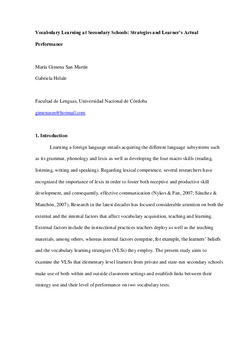| dc.contributor.author | San Martin, María Gimena | |
| dc.contributor.author | Helale, Gabriela | |
| dc.date.accessioned | 2022-11-09T19:07:15Z | |
| dc.date.available | 2022-11-09T19:07:15Z | |
| dc.date.issued | 2015 | |
| dc.identifier.isbn | 978-987-45982-0-2 | |
| dc.identifier.uri | http://hdl.handle.net/11086/29533 | |
| dc.description.abstract | Along with grammar and phonology, lexis is crucial to both receptive and productive skill development, and consequently, effective communication (Nykos & Fan, 2007; Sánchez & Manchón, 2007). Much research in the field of vocabulary acquisition, teaching and learning has focused on keys aspects such as vocabulary growth (Tschirner, 2004; Webb & Chang, 2012) and explicit vocabulary teaching (Nation, 2005). Other dimensions of analysis include both the external and the internal factors that influence the development of lexical competence. External factors include the instructional practices teachers deploy as well as the teaching materials, among others, whereas internal factors comprise, for example, the learners? beliefs and the vocabulary learning strategies (VLS) they employ. The present work draws on the findings reported by a research project conducted at the School of Languages, Córdoba State University, which analyzed the internal factors which affect vocabulary acquisition. The project involved examining these factors at different classroom settings. The study reported here is concerned with one of the internal factors: the learning strategies that learners make use of when learning vocabulary at three different secondary schools. Therefore, the purpose of this study is to establish links between the vocabulary learning strategies the learners make use of both within and outside classroom settings and the results of two vocabulary tests administered on two different occasions. A survey and two vocabulary tests were the data collection strategies. The participants of the study were secondary school learners at three different institutions: a private secondary school, a state-run secondary school and a pre-university school. Data analysis comprised correlating the learners' performance in the tests with their VLS. We report on the similarities and the differences between the three groups of learners. This study aims to further contribute to research on vocabulary acquisition and vocabulary instruction. | es |
| dc.description.uri | https://www.academia.edu/16235625/EFL_classrooms_in_the_new_millennium_Selected_papers_from_the_40th_FAAPI_Conference | |
| dc.format.medium | Electrónico y/o Digital | |
| dc.language.iso | eng | es |
| dc.rights | Attribution-NonCommercial-ShareAlike 4.0 International | * |
| dc.rights.uri | http://creativecommons.org/licenses/by-nc-sa/4.0/ | * |
| dc.subject | Vocabulary | es |
| dc.subject | Vocabulary learning strategies | es |
| dc.subject | Secondary school | es |
| dc.title | Vocabulary learning at Secondary Schools : strategies and learner´s actual performance | es |
| dc.type | conferenceObject | es |
| dc.description.fil | Fil: San Martin, María Gimena. Universidad Nacional de Córdoba. Facultad de Lenguas; Argentina. | es |
| dc.description.fil | Fil: Helale, Gabriela. Universidad Nacional de Córdoba. Facultad de Lenguas; Argentina. | es |
| dc.description.field | Lingüística | |
| dc.conference.city | Córdoba | |
| dc.conference.country | Argentina | |
| dc.conference.editorial | ACPIAsociación Cordobesa de Profesores de Inglés | |
| dc.conference.event | 40th FAAPI Annual Conference in Cordoba | |
| dc.conference.eventcity | Córdoba | |
| dc.conference.eventcountry | Argentina | |
| dc.conference.eventdate | 2015-9 | |
| dc.conference.institution | ACPI & FAAPI | |
| dc.conference.journal | EFL classrooms in the new millennium: Selected papers from the 40th FAAPI Conference | |
| dc.conference.publication | Libro | |
| dc.conference.work | Artículo Completo | |
| dc.conference.type | Congreso | |





